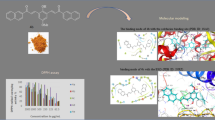Abstract
Hydroxychalcones act as autophagy inducers and methoxy chalcones induce apoptosis. Additionally, benzoflavones inhibit the hepatitis C virus. Based on these findings, a chalcone derivative, 2-hydroxy-4-methoxy-2′,3′-benzochalcone, was prepared. It showed antimitotic activity through its inhibitory effect on tubulin polymerization. Its molecular binding mode with tubulin was elucidated using in silico docking and nuclear magnetic resonance spectroscopy. In addition, the three-dimensional structure of 2-hydroxy-4-methoxy-2′,3′-benzochalcone was determined by X-ray crystallography.
Similar content being viewed by others
References
Abdullah M, Mahmood A, Madni M, Masood S, and Kashif M (2014) Synthesis, characterization, theoretical, anti-bacterial and molecular docking studies of quinoline based chalcones as a DNA gyrase inhibitor. Bioorg Chem 54C, 31–7.
Fukazawa H, Suzuki T, Wakita T, and Murakami Y (2012) A cell-based, microplate colorimetric screen identifies 7,8-benzoflavone and green tea gallate catechins as inhibitors of the hepatitis C virus. Bio Pharm Bull 35, 1320–7.
Hwang D, Hyun J, Jo G, Koh D, and Lim Y (2011) Synthesis and complete assignment of NMR data of 20 chalcones. Magn Reson Chem 49, 41–5.
Hwang D, Jo G, Hyun J, Lee S, Koh D, and Lim Y (2012) Synthesis of methoxybenzoflavones and assignments of their NMR data. Magn Reson Chem 50, 62–7.
Kim H, Lee E, Kim J, Jung B, Chong Y, Ahn JH, Lim Y (2008) A flavonoid gossypin binds to cyclin-dependent kinase 2. Bioorg Med Chem Lett 18, 661–4.
Kramer B, Rarey M, and Lengauer T (1999) Evaluation of the FLEXX incremental construction algorithm for protein-ligand docking. Proteins 37, 228–41.
Parveen Z, Brunhofer G, Jabeen I, Erker T, Chiba P, and Ecker G (2014) Synthesis, biological evaluation and 3D-QSAR studies of new chalcone derivatives as inhibitors of human P-glycoprotein. Bioorg Med Chem 22, 2311–9.
Shin S, Jung H, Ahn S, Hwang D, Yoon H, Hyun J, Yong Y, Cho H, Koh D, Lee Y, and Lim Y (2014) Polyphenols bearing cinnamaldehyde scaffold showing cell growth inhibitory effects on the cisplatin-resistant A2780/Cis ovarian cancer cells. Bioorg Med Chem 22, 1809–20.
Shin S, Kim J, Yoon H, Choi Y, Koh D, Lim Y, and Lee Y (2013a) Novel antimitotic activity of 2-hydroxy-4-methoxy-2′,3′-benzochalcone (HymnPro) through the inhibition of tubulin polymerization. J Agric Food Chem 61, 12588–97.
Shin S, Yoon H, Ahn S, Kim D, Kim S, Koh D, Lee Y, and Lim Y (2013b) Chromenylchalcones showing cytotoxicity on human colon cancer cell lines and in silico docking with aurora kinases. Bioorg Med Chem 21, 4250–8.
Shin S, Yoon H, Hwang D, Ahn S, Kim D, Koh D, Lee Y, and Lim Y (2013c) Benzochalcones bearing pyrazoline moieties show anti-colorectal cancer activities and selective inhibitory effects on aurora kinases. Bioorg Med Chem 21, 7018–24.
Sun Y, Huang W, Hsiao C, Chen Y, Lu P, and Guh J (2010) Methoxychalcone induces cell-cycle arrest and apoptosis in human hormone-resistant prostate cancer cells through PI 3-kinase-independent inhibition of mTOR pathways. Prostate 70, 1295–306.
Wang F, Wang S, Zhao B, and Miao J (2014) Discovery of 2′-hydroxychalcones as autophagy inducer in A549 lung cancer cells. Org Biomol Chem 12, 3062–70.
Zhou X, Ma H, Zhang Z, Jing S, Miao J, and Zhao B (2014) Synthesis of 6-cinnamoyl-2H-benzo[b][1,4]oxazin-3(4H)-ones and their effects on A549 lung cancer cell growth. Eur J Med Chem 79, 95–101.
Author information
Authors and Affiliations
Corresponding authors
Electronic supplementary material
Rights and permissions
About this article
Cite this article
Yong, Y., Shin, S.Y., Jung, H. et al. Investigation of 2-hydroxy-4-methoxy-2′,3′-benzochalcone binding to tubulin by using NMR and in silico docking. J Korean Soc Appl Biol Chem 57, 693–698 (2014). https://doi.org/10.1007/s13765-014-4181-2
Received:
Accepted:
Published:
Issue Date:
DOI: https://doi.org/10.1007/s13765-014-4181-2




